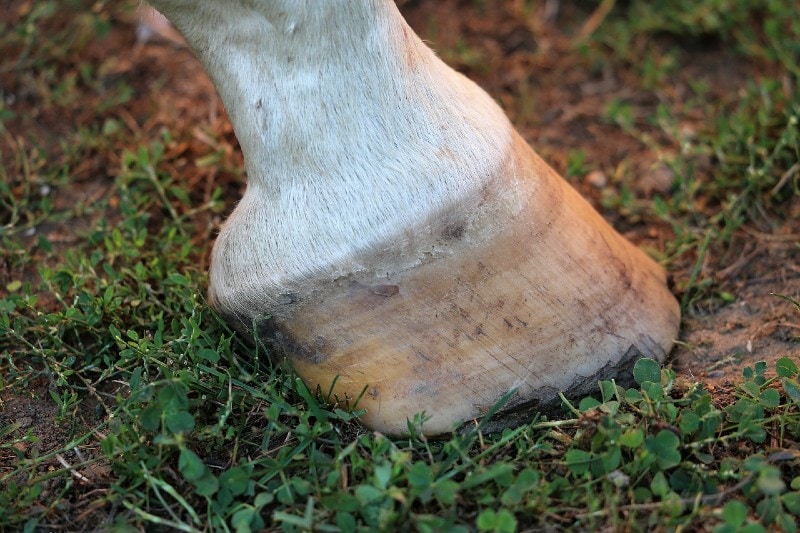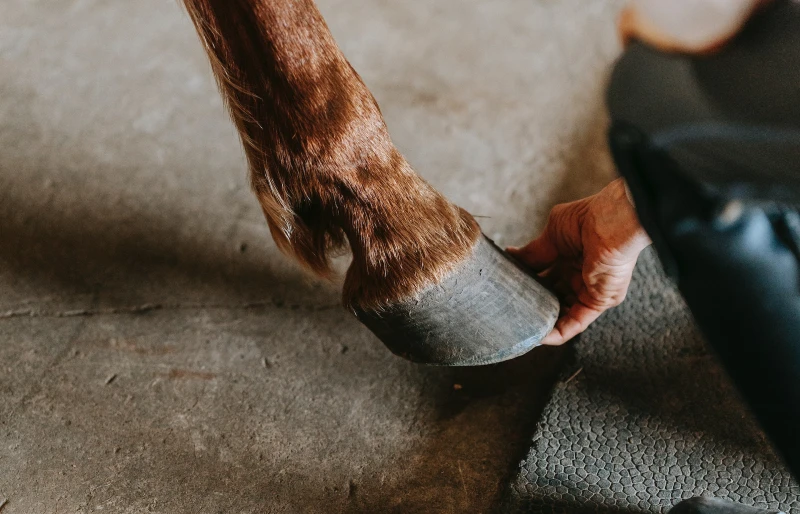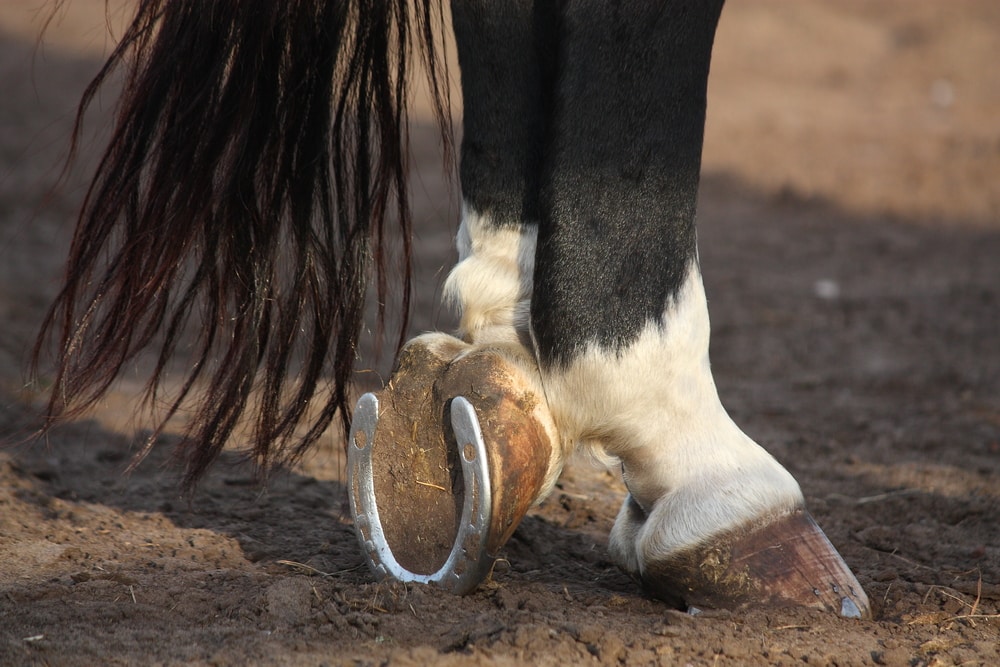
Cleaning your horse’s hooves is an essential part of your daily care routine and getting the job done correctly is not only essential for the health of their hooves, but for their mobility and overall health. Knowing how to clean hooves properly will prevent them from becoming impacted, uncomfortable, and from becoming a breeding ground for bacteria and infection.
You should plan on cleaning your horse’s hooves out at least once per day. Depending on what activities you’ve done, and which surfaces they’ve been walking on throughout the day, it may be an idea to clean them out multiple times. That’s why we’ve provided a step-by-step guide, to walk you through the entire process of cleaning those horse hooves and keeping yourself safe while you do it.
How to Clean a Horse’s Hoof
1. Tie Your Horse Up Securely
First and foremost, you need to properly tie up and secure your horse before you start cleaning the hooves. Not only is this for your own safety as it limits their movement, but you also don’t want your horse walking away during the process.
Aim to tie them up in a quiet area that is free of distractions, including other horses, as you don’t want anything to startle or disrupt your horse while you are working on their feet. If they are feeling their oats that day, calm them down before you begin.
Make sure the rope isn’t too tight, but also don’t provide too much slack since you don’t want them lowering their head to graze. You can even have another person hold onto the lead if you prefer.

2. Position Yourself Correctly
Safety should always be your top priority when handling horses. As owners, it can be easy to get complacent, especially when working with horses we know well. Unless your horse has been desensitized to hoof maintenance, they can be very sensitive to having their feet messed with.
If you don’t know the horse well, be extra cautious during the process. You want to position yourself in the safest, most effective way to clean the hooves to prevent yourself from being kicked or stepped on. Additionally, you need to make sure your horse is aware of your movement as you make your way around their body.
To keep yourself from being in the direct path of the leg you are working on, stand beside your horse, facing their behind. Never stand directly in front of or behind any of the legs.
3. Encourage Your Horse to Shift Their Weight
Depending on which side of the body you are working on, you want to make sure your horse has shifted their weight to the other. This will allow them to pick their leg up comfortably and remain stable as you work.
Horses that are well trained and used to having their hooves cleaned and trimmed may naturally do this since they are familiar with the process. Otherwise, you can gently nudge your horse with your shoulder to encourage them to shift their weight to the opposite side. Don’t even attempt to lift the leg until their weight has been shifted properly.

4. Cue Your Horse to Lift the Leg
The last thing you want to do when messing with your horse’s feet is to catch them by surprise when you go to grab a leg. This is especially important if you are working with a horse that is green, or one that you are not yet familiar with. If this is the case, exercise extreme caution and get a feel for how the horse is responding before you begin.
A great way to reassure them is by running your hand up and down their leg while talking in a calm, loving tone. You can also check their leg out to ensure there are no injuries, swelling, or anything unusual going on with the leg.
If your horse does not have a cue to pick up their leg, you can gently squeeze the chestnut on the front legs or the hock, if working on the back legs, to encourage them to lift. You can position yourself against your horse so that you can feel their movements and be more in tune with them as you work.
5. Support the Hoof
You are going to need to hold each leg in a way that supports the hoof and gives you the correct leverage to pick. If your horse tries to pull away or put their leg back down, hold the toe of the hoof and lift it up toward the elbow. Support the hoof you are working on with the hand closest to your horse’s body, allowing the hand farthest from the body to use the hoof pick.
Each horse is an individual, so do your best to understand what makes them the most comfortable during the process. Find out what works for your horse and position yourself in a way that supports them comfortably while being safe for you.

6. Begin Using the Pick to Clean the Hoof
Once you have the hoof supported in your hand, you can start cleaning. Start by removing any dirt, rock, debris, or other material from the frog, which is the area that collects the most mess. The frog can be very sensitive since it has nerve endings, so you can always start with your fingers or a brush before moving to the pick. Regardless, be very gentle with the area.
Work carefully from heel to toe and avoid abrupt movement so that you avoid losing control and injuring yourself or your horse. Use a swiping motion parallel to the hoof and pick away at any gravel, dirt, debris, and anything else that has gathered in the hoof.
A standard pick will get the job done, but you can opt to use a pick with a brush to clean up the area even more. The frog will occasionally shed, and areas may look like they are peeling or hanging off, if that’s the case, give a gentle tug with your fingers. If it doesn’t fall off, leave it be and never attempt to cut it back yourself.
7. Check the Hooves
Once you’ve finished cleaning out the hoof, give it a once over to make sure you didn’t miss anything that needs to be cleaned out. You should also check hoof health to make sure each one is balanced and there are no signs of cracking, trauma, or infection.
Your horse should be able to stand squarely with all hooves in contact with the ground. If they are in need of a trim, you can either do so yourself if you have the experience or contact a professional farrier service. Hooves should be trimmed every 6 to 8 weeks on average for optimal hoof maintenance. If there are any signs of injury, trauma, or infection, reach out to your veterinarian.

Conclusion
Horse owners should plan on cleaning out their horse’s hooves at least once per day as part of their daily routine. Each horse is unique, so it’s important to know your horse’s likes and dislikes, and how they respond to certain situations like hoof cleaning. You should always make safety your top priority, and ensure you take all necessary precautions to prevent you and your horse from injury.
The process is quite simple once you get the hang of it and learn how to position yourself properly. Always err on the side of caution and be especially careful with horses that are either green or you don’t know very well.
Featured Image Credit: Brastock, Shutterstock
The post How to Clean a Horse’s Hoof: Vet-Reviewed Step-By-Step Guide appeared first on Pet Keen.


Leave a Reply